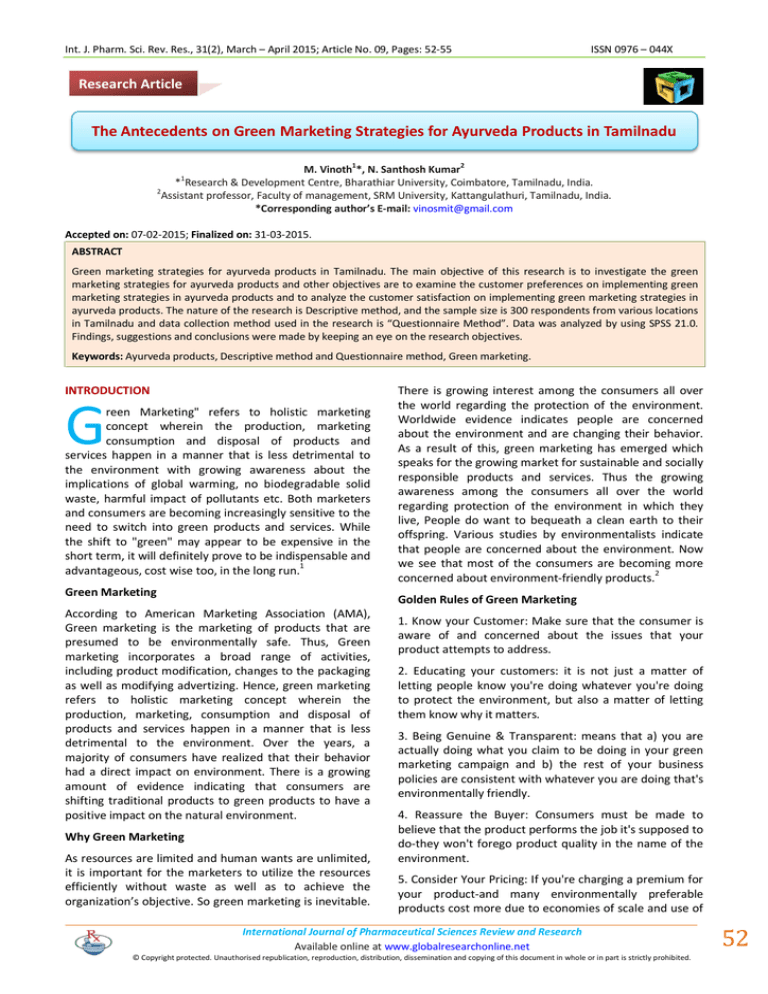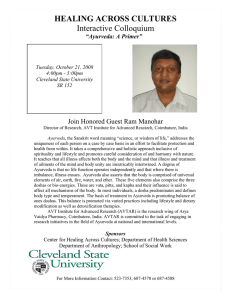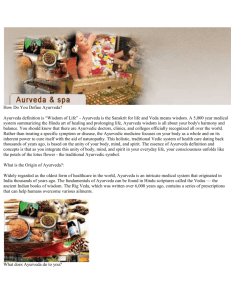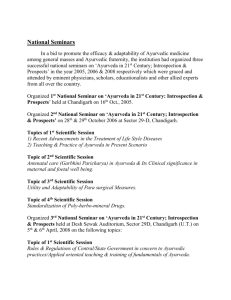Document 13310342
advertisement

Int. J. Pharm. Sci. Rev. Res., 31(2), March – April 2015; Article No. 09, Pages: 52-55 ISSN 0976 – 044X Research Article The Antecedents on Green Marketing Strategies for Ayurveda Products in Tamilnadu 1 2 M. Vinoth *, N. Santhosh Kumar * Research & Development Centre, Bharathiar University, Coimbatore, Tamilnadu, India. 2 Assistant professor, Faculty of management, SRM University, Kattangulathuri, Tamilnadu, India. *Corresponding author’s E-mail: vinosmit@gmail.com 1 Accepted on: 07-02-2015; Finalized on: 31-03-2015. ABSTRACT Green marketing strategies for ayurveda products in Tamilnadu. The main objective of this research is to investigate the green marketing strategies for ayurveda products and other objectives are to examine the customer preferences on implementing green marketing strategies in ayurveda products and to analyze the customer satisfaction on implementing green marketing strategies in ayurveda products. The nature of the research is Descriptive method, and the sample size is 300 respondents from various locations in Tamilnadu and data collection method used in the research is “Questionnaire Method”. Data was analyzed by using SPSS 21.0. Findings, suggestions and conclusions were made by keeping an eye on the research objectives. Keywords: Ayurveda products, Descriptive method and Questionnaire method, Green marketing. INTRODUCTION G reen Marketing" refers to holistic marketing concept wherein the production, marketing consumption and disposal of products and services happen in a manner that is less detrimental to the environment with growing awareness about the implications of global warming, no biodegradable solid waste, harmful impact of pollutants etc. Both marketers and consumers are becoming increasingly sensitive to the need to switch into green products and services. While the shift to "green" may appear to be expensive in the short term, it will definitely prove to be indispensable and advantageous, cost wise too, in the long run.1 Green Marketing There is growing interest among the consumers all over the world regarding the protection of the environment. Worldwide evidence indicates people are concerned about the environment and are changing their behavior. As a result of this, green marketing has emerged which speaks for the growing market for sustainable and socially responsible products and services. Thus the growing awareness among the consumers all over the world regarding protection of the environment in which they live, People do want to bequeath a clean earth to their offspring. Various studies by environmentalists indicate that people are concerned about the environment. Now we see that most of the consumers are becoming more concerned about environment-friendly products.2 Golden Rules of Green Marketing According to American Marketing Association (AMA), Green marketing is the marketing of products that are presumed to be environmentally safe. Thus, Green marketing incorporates a broad range of activities, including product modification, changes to the packaging as well as modifying advertizing. Hence, green marketing refers to holistic marketing concept wherein the production, marketing, consumption and disposal of products and services happen in a manner that is less detrimental to the environment. Over the years, a majority of consumers have realized that their behavior had a direct impact on environment. There is a growing amount of evidence indicating that consumers are shifting traditional products to green products to have a positive impact on the natural environment. Why Green Marketing As resources are limited and human wants are unlimited, it is important for the marketers to utilize the resources efficiently without waste as well as to achieve the organization’s objective. So green marketing is inevitable. 1. Know your Customer: Make sure that the consumer is aware of and concerned about the issues that your product attempts to address. 2. Educating your customers: it is not just a matter of letting people know you're doing whatever you're doing to protect the environment, but also a matter of letting them know why it matters. 3. Being Genuine & Transparent: means that a) you are actually doing what you claim to be doing in your green marketing campaign and b) the rest of your business policies are consistent with whatever you are doing that's environmentally friendly. 4. Reassure the Buyer: Consumers must be made to believe that the product performs the job it's supposed to do-they won't forego product quality in the name of the environment. 5. Consider Your Pricing: If you're charging a premium for your product-and many environmentally preferable products cost more due to economies of scale and use of International Journal of Pharmaceutical Sciences Review and Research Available online at www.globalresearchonline.net © Copyright protected. Unauthorised republication, reproduction, distribution, dissemination and copying of this document in whole or in part is strictly prohibited. 52 © Copyright pro Int. J. Pharm. Sci. Rev. Res., 31(2), March – April 2015; Article No. 09, Pages: 52-55 higher-quality ingredients-make sure those consumers can afford the premium and feel it's worth it. Review of Literature 3 (Kohli, 2006) Ayurveda has been a lively system of health with an unbroken practice since 3000 years. Although , Ayurveda as a system of medicine has been in practice in India for centuries but its growth as an industry has commenced only a few years back. This was mainly on account of lack of awareness and initiative by its practitioners, industry and even the Government. We have been non-receptive and reclusive for modern techniques and advancement that has occurred in the modern techniques and advancement that has occurred in the modern Pharma industry. The classical drugs like Dashmmolarishta and Arjunarishta are also in practice since then. In recent past, the tradition of preparation of medicines by the Ayurvedic practitioner has almost come to an end. Now we find a much organized and commercial production of Ayurvedic medicines in big factories. Ayurveda and its products are becoming popular with increasing demand the world over. The pressure of the people of the respective countries to adopt Ayurvedic products have amounted to many countries now allowing and regularizing sale of these products in to their countries. This has boosted the globalization process. But this initial phase is primarily the phase of enquiry and curiosity Ayurveda has to live upto the expectations, otherwise we have the risk of getting washed out forever. Hence, Ayurveda needs immediate and extensive reorientation to gain scientific credibility, as this traditional old system of medicine if given the opportunity, is poised for an unprecedented expansion globally. There is, therefore, a need to transform Ayurveda into a dynamic, scientifically validated and evidence based which takes its roots from rich knowledge base of oral tradition and scriptures. The major hurdle in the wider acceptability of Ayurveda and its products is the lack of proper standardization techniques and its unpreparedness to accept global challenges. The quality of raw drugs used in manufacturing as well as the finished drugs of Ayurveda and other traditional systems from India are seen with a suspicion. We need to reassure our global partners by providing them evidence of quality of medicines we prepare in terms of reproducible efficacy and standardization.4 Previous Studies Related to Green Marketing Manian and Nithish (2014)5 explains that green marketing is a phenomenon which has developed particular important in the modern marketing era and has emerged as an important concept in India as in other parts of the developing and developed world, and is seen as an important strategy of facilitating sustainable development. In this research paper, main emphasis has been made of concept, need and importance of green marketing. The Paper aims at finding out what actually Green Marketing is all about and how can a business firm ISSN 0976 – 044X be more competitive by using green marketing strategies to gain a competitive edge over others. The paper also examines the present trends of green marketing. It also discusses on challenges of green marketing and concludes that green marketing is something that will continuously grow in practice. Kilbourne, W.E. (1998)6 discussed the failure of green marketing to move beyond the limitations of the prevailing paradigm. The author identified areas that must be examined for their effect in the marketing/environment relationship, namely economic, political and technological dimensions of the cultural frame of reference. Prothero, A. (1998)7 introduced several papers discussed in the July 1998 issue of 'Journal of Marketing Management' focusing on green marketing. This included a citation of the need to review existing literature on green marketing, an empirical study of United States and Australian marketing managers, a description of what a green alliance look like in practice in Great Britain, ecotourism and definitions of green marketing. Prothero, A. & Fitchett, J.A. (2000)8 argued that greater ecological enlightenment can be secured through capitalism by using the characteristics of commodity culture to further progress environmental goals. Marketing not only has the potential to contribute to the establishment of more sustainable forms of society but, as a principle agent in the operation and proliferation of commodity discourse, also has a considerable responsibility to do so. Oyewole, P. (2001)9 in his paper presented a conceptual link among green marketing, environmental justice, and industrial ecology. It argues for greater awareness of environmental justice in the practice for green marketing. A research agenda is finally suggested to determine consumer's awareness of environmental justice, and their willingness to bear the costs associated with it. Karna, J., Hansen, E. & Juslin, H. (2003)10 interpreted that proactive marketers are the most genuine group in implementing environmental marketing voluntarily and seeking competitive advantage through environmental friendliness. The results also give evidence that green values, environmental marketing strategies, structures and functions are logically connected to each other as hypothesized according to the model of environmental marketing used to guide this study. RESEARCH OBJECTIVES To investigate the green marketing strategies for ayurveda products. To examine the customer preferences on implementing green marketing strategies in ayurveda products. To analyze the customer satisfaction on implementing green marketing strategies in ayurveda products. International Journal of Pharmaceutical Sciences Review and Research Available online at www.globalresearchonline.net © Copyright protected. Unauthorised republication, reproduction, distribution, dissemination and copying of this document in whole or in part is strictly prohibited. 53 © Copyright pro Int. J. Pharm. Sci. Rev. Res., 31(2), March – April 2015; Article No. 09, Pages: 52-55 Research Methodology The nature of the research is Descriptive method, and the sample size is 300 respondents from various locations in Tamilnadu and data collection method used in the research is “Questionnaire Method”. Data was analyzed by using SPSS 21.0. Findings, suggestions and conclusions were made by keeping an eye on the research objectives. Research Hypotheses (H1): There is an impact or influence on paper bag as a green marketing strategy in ayurveda industries. (H1): There is an impact or influence on printed newspapers as a covering bags as a green marketing strategy in ayurveda industries. (H1): There is an impact or influence on cloth bags as a green marketing strategy in ayurveda industries. (H1): There is an impact or influence on cotton boxes for packaging as a green marketing strategy in ayurveda industries. (H1): There is an impact or influence on using green raw materials as a green marketing strategy in ayurveda industries. ISSN 0976 – 044X way as to minimize the total error. SSres. This process also maximizes the correlation between the actual values of Y and the predicted values. Most of the statistical terms described under bivariate regression also apply. To multiple regression, the statistics are used: Adjusted R2 - R2, coefficient of multiple determination, is adjusted for the number of independent variables and the sample size to account for diminishing returns. After the first few variables, the additional independent variables do not make much contribution. Coefficient of multiple determinations - The strength of association in multiple regression is measured by the 2 square of the multiple correlation coefficient, R , which is also called the coefficient of multiple determination. The F test is used to test the null hypothesis that the coefficient of multiple determinations in the population, R2pop, is zero. This is equivalent to testing the null hypothesis H0; β1= β2= β3…… = βk= 0. The test statistic has an F distribution with k and (n- k - 1) degrees of freedom. The partial regression coefficient, b1, denotes the change in the predicted value, Y, per unit change in X1 when the other independent variables, X2 to Xk, are held constant. Model Summary R Square Adjusted R Square Std. Error of the Estimate .486 .323 .981 (H1): There is an impact or influence on without using chemicals as a green marketing strategy in ayurveda industries. Model R 1 .697 (H1): There is an impact or influence on artificial preservatives as a green marketing strategy in ayurveda industries. Dependent Variable: Green marketing strategies ANALYSIS AND INTERPRETATIONS Multiple regressions is an extension of the bivariate linear regression. It is a statistical tool used to develop a self weighting estimating equation that predicts values for a dependent variable from the values of independent variable; controls confounding variables to bester evaluate the contribution of other variables; tests and explains a causal theory. Although dummy variables may be used, all other variables must be interval or ratio the generalized equation is a Coefficients Model Unstandardized Coefficients Standardized Coefficients t Sig. .661 .516 .005 .032 .975 .181 -.035 -.187 .853 B Std. Error (Constant) .660 .999 Paper bag .005 .169 Printed newspapers as a covering bags -.034 Beta Cloth bags .367 .208 .391 1.765 .092 Cotton boxes for packaging -.056 .219 -.057 -.257 .800 Using green Raw materials .120 .154 .134 .778 .045 β0 = a constant, the value of Y when all X valued are zero Without using chemicals .007 .165 .009 .041 .967 βi = the slope of the regression surface ( the β represents the regression coefficient associated with each X1) Artificial preservatives .391 .196 .423 1.994 .049 Y = β0 + β1 X1 +β2 X2 + β3 X3 +……+ βk Xk + e. Where e = an error term, normally distributed about a mean of 0 (for purpose of computation, the e is assumed to be 0) This is estimated by the following equation: Y = a + b1 X1 + b2 X2 + b3 X3 +……+ bk Xk As before, the coefficient a represents the intercept, but the bs are now the partial regression coefficients. The least squares criterion estimates the parameters in such a Dependent Variable: Green marketing strategies RESULTS AND RECOMMENDATIONS The following attributes can be accepted by the ayurveda customers as green marketing strategies. Artificial preservatives - Artificial preservatives are a group of chemical substances added to food, sprayed on the outside of food, or added to certain medications to International Journal of Pharmaceutical Sciences Review and Research Available online at www.globalresearchonline.net © Copyright protected. Unauthorised republication, reproduction, distribution, dissemination and copying of this document in whole or in part is strictly prohibited. 54 © Copyright pro Int. J. Pharm. Sci. Rev. Res., 31(2), March – April 2015; Article No. 09, Pages: 52-55 retard spoilage, discoloration, or contamination by bacteria and other disease organisms. Using green Raw materials – Green marketing is, as far as possible, based on various renewable raw materials, such Paper bag ISSN 0976 – 044X as vegetable oils and fatty acids. The challenge is to find suitable microorganisms and enzyme systems which effectively transform the raw materials into useable and eatable substances. Printed news papers as a covering bags Cotton boxes for packaging Green marketing strategies Cloth bags Without using chemicals Using green raw materials Artificial preservatives CONCLUSION Green marketing strategies for ayurveda products in Tamilnadu. The main objective of this research is to investigate the green marketing strategies for ayurveda products and other objectives are to examine the customer preferences on implementing green marketing strategies in ayurveda products and to analyze the customer satisfaction on implementing green marketing strategies in ayurveda products. The nature of the research is Descriptive method, and the sample size is 300 respondents from various locations in Tamilnadu and data collection method used in the research is “Questionnaire Method”. Data was analyzed by using SPSS 21.0. The result of the study which indicates that ayurveda industr in Tamilnadu should use artificial preservatives and green materials as green marketing strategies. 3. Kohil, Current scenario of ayurvedic industry and the way forward, PARIPEX - Indian Journal of Research, 3(3), 2014, 72-73. 4. Manian and Nithish, Present Green Marketing - Brief Reference To Indian Scenario, International Journal of scientific research and management, 2014, 51-57. 5. Kilbourne WE, Green Marketing: A Theoretical Perspective, Journal of Marketing Management, 14(6), 1998, 641-656. 6. Prothero A, Green Marketing: The 'Fad' That Won't Slip Slide Away, Journal of Marketing Management, 14(6), 1998, 507-513. 7. Prothero A, Fitchett JA, Greening Capitalism: Opportunities for Green Community. Journal of Macromarketing, 20(1), 2000, 46-56. 8. Oyewole P, Social Costs of Environmental Justice Associated with the Practice of Green Marketing, Journal of Business Ethics, 29(3), 2001, 239-252. 9. Karna J, Hansen E, Juslin H, Social Responsibility in Environmental Marketing Planning, European Journal of Marketing, 37(5/6), 2003, 848-873. REFERENCES 1. Sudha, Green Marketing in India, NAMEX International Journal of Management Research , 2(1), 2012, 103-110. 2. Gondaliya, Green Marketing in India, PARIPEX - INDIAN JOURNAL OF RESEARCH, 3(3), 2014, 72-73. Source of Support: Nil, Conflict of Interest: None. International Journal of Pharmaceutical Sciences Review and Research Available online at www.globalresearchonline.net © Copyright protected. Unauthorised republication, reproduction, distribution, dissemination and copying of this document in whole or in part is strictly prohibited. 55 © Copyright pro





